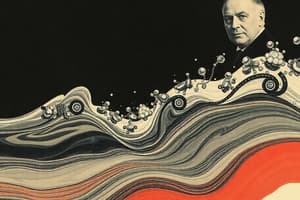Podcast
Questions and Answers
What is the role of turbulence in hydrotherapy?
What is the role of turbulence in hydrotherapy?
- To enhance the speed of movement through water.
- To assist and resist movement, improving balance and coordination. (correct)
- To completely eliminate water resistance during movement.
- To reduce the need for any additional equipment.
What does Pascal's law state regarding hydrostatic pressure?
What does Pascal's law state regarding hydrostatic pressure?
- Fluid pressure increases only in the downward direction.
- Fluid pressure is exerted equally on all surface areas of an immersed body at rest at a given depth. (correct)
- Fluid pressure decreases as the depth of immersion increases.
- Fluid pressure is exerted more on the top surface than on the bottom surface.
How does increasing depth affect hydrostatic pressure?
How does increasing depth affect hydrostatic pressure?
- It diminishes the pressure exerted on the body.
- It raises the pressure exerted on the body and surrounding fluids. (correct)
- It only affects the pressure on the lower extremities.
- It maintains a constant level of pressure regardless of depth.
What potential problems can increased hydrostatic pressure cause for certain patients?
What potential problems can increased hydrostatic pressure cause for certain patients?
What is affected by applying equipment like gloves and paddles in water exercises?
What is affected by applying equipment like gloves and paddles in water exercises?
What effect does increasing the surface area moving through water have on resistance?
What effect does increasing the surface area moving through water have on resistance?
How is relative density defined?
How is relative density defined?
What is the result of an object having a higher density than the liquid it is placed in?
What is the result of an object having a higher density than the liquid it is placed in?
Which of the following best describes laminar flow?
Which of the following best describes laminar flow?
What happens to drag force when the speed of motion increases?
What happens to drag force when the speed of motion increases?
What does stabilizing an extremity proximate during manual resisted exercise require from the patient?
What does stabilizing an extremity proximate during manual resisted exercise require from the patient?
What is the clinical significance of moving through the surface of a fluid?
What is the clinical significance of moving through the surface of a fluid?
How does drag force impact aquatic therapy?
How does drag force impact aquatic therapy?
What does Archimede's Principle state about a body immersed in a liquid?
What does Archimede's Principle state about a body immersed in a liquid?
Which of the following hydrodynamic principles relates most directly to the resistance felt when moving through water?
Which of the following hydrodynamic principles relates most directly to the resistance felt when moving through water?
In hydrotherapy, what is the therapeutic benefit of using warm water between 90 and 95 degrees Fahrenheit?
In hydrotherapy, what is the therapeutic benefit of using warm water between 90 and 95 degrees Fahrenheit?
What effect does posteriorly placed buoyancy have on a patient in a vertical position?
What effect does posteriorly placed buoyancy have on a patient in a vertical position?
How much body weight does a person off-load when immersed to the xiphoid process?
How much body weight does a person off-load when immersed to the xiphoid process?
The center of buoyancy of an immersed object is crucial because it:
The center of buoyancy of an immersed object is crucial because it:
Which of the following is NOT a principle of hydrodynamics?
Which of the following is NOT a principle of hydrodynamics?
What is the primary purpose of hydrotherapy in rehabilitation?
What is the primary purpose of hydrotherapy in rehabilitation?
Flashcards
Hydrostatic Pressure
Hydrostatic Pressure
Pressure exerted by fluid molecules on an immersed object. It's equal in all directions.
Turbulence in Hydrotherapy
Turbulence in Hydrotherapy
Movement of water created by an object moving through it. Can be used to assist or resist movement
Turbulence & Movement
Turbulence & Movement
Movement of an object through a fluid (water) creates eddies and swirls.
Hydrostatic Pressure Effect
Hydrostatic Pressure Effect
Signup and view all the flashcards
Equipment Drag
Equipment Drag
Signup and view all the flashcards
Viscosity
Viscosity
Signup and view all the flashcards
Surface Tension
Surface Tension
Signup and view all the flashcards
Relative Density
Relative Density
Signup and view all the flashcards
Laminar Flow
Laminar Flow
Signup and view all the flashcards
Turbulent Flow
Turbulent Flow
Signup and view all the flashcards
Drag Force
Drag Force
Signup and view all the flashcards
Manual Resisted Exercise (Aquatic)
Manual Resisted Exercise (Aquatic)
Signup and view all the flashcards
Hydromechanics
Hydromechanics
Signup and view all the flashcards
Hydrotherapy
Hydrotherapy
Signup and view all the flashcards
Buoyancy
Buoyancy
Signup and view all the flashcards
Archimedes' Principle
Archimedes' Principle
Signup and view all the flashcards
Center of Buoyancy (COB)
Center of Buoyancy (COB)
Signup and view all the flashcards
Clinical Significance of Buoyancy
Clinical Significance of Buoyancy
Signup and view all the flashcards
COB and Body Position
COB and Body Position
Signup and view all the flashcards
Weight Offloading in Water
Weight Offloading in Water
Signup and view all the flashcards
Hydrotherapy for Rehabilitation
Hydrotherapy for Rehabilitation
Signup and view all the flashcards
Study Notes
PT-PAP 101 Hydrodynamic Principles
- Hydrodynamic principles are used in hydrotherapy, a therapeutic treatment performed in underwater.
- Hydrotherapy is suitable for conditions where land-based exercise is not.
- Hydrotherapy uses warm water (90-95°F).
- It's a popular treatment for patients with neurological and musculoskeletal conditions.
Objectives
- Students should be able to explain hydrodynamic principles.
- Students should be able to correlate hydrotherapy principles to rehabilitation aspects.
Uses in Physiotherapy
- Hydrotherapy, also known as aquatherapy, assists in rehabilitation and recovery from clinical conditions unsuitable for land-based exercises.
Hydrodynamic Principles
- Buoyancy
- Turbulence
- Friction
- Hydrostatic pressure
- Relative density
Buoyancy
- Archimedes' Principle: A fully or partially submerged body experiences an upward thrust equal to the weight of the fluid it displaces..
- 90% body weight reduction occurs when fully immersed.
- Percentage off-loaded increases with immersion depth.
Clinical Significance of Buoyancy
- Provides relative weightlessness and joint unloading in water. This makes exercises easier on joints.
- Allows three-dimensional access to the patient, enabling easier assessment and treatment of specific areas.
Center of Buoyancy
- The reference point of an immersed object where buoyant forces act vertically.
- Vertical forces that don't intersect the center of buoyancy create rotational motion.
- A vertical position of the body will have the center of buoyancy at the sternum.
- A posteriorly placed center of buoyancy causes the patient to lean forward.
- An anterior placed center of buoyancy will cause the patient to lean back.
Clinical Application of Buoyancy
- Immersion to the symphysis pubis offloads approximately 40% of body weight.
- Immersion to the umbilicus offloads around 50% of body weight.
- Immersion to the xiphoid offloads 60% or more of body weight.
- Immersion to the shoulders offloads around 85% of body weight, depending on arm position.
Viscosity
- Friction between liquid molecules creates resistance to flow.
- Viscosity creates resistance to all active movement.
Clinical Significance of Viscosity
- Increasing surface area moving through water will increase resistance to movement.
- Stabilizing an extremity proximally requires more work from the patient.
- Stabilizing an extremity distally requires less work from the patient.
Surface Tension
- Surface of a fluid acts as a membrane under tension.
- Measured as force per unit length.
- Extremity moving through the surface of the water requires more work as resistance is increased.
- Equipment at or near the surface of the water increases resistance to movement.
Relative Density
- Relative density compares the density of an object to the density of water at 4°C.
- Objects denser than the water sink.
- Objects less dense than the water float.
- Water (1 cm²) has a mass of 1 gram.
Hydromechanics
- Physical properties and characteristics of fluid in motion.
- Components of flow motion (Laminar flow, Turbulence flow,and drag).
Laminar Flow
- Movement where all molecules move parallel to each other.
Turbulence Flow
- Movement where molecules do not move parallel—typically faster movement
Drag Force
- Most important concept in aquatic therapy.
- Frictional resistance of an object.
- Greater surface area or unstreamlined body position increase resistance.
- Position or shape changes can influence drag.
- Increased speed of motion increases drag (streamlining).
Clinical Significance of Drag Force
- Increased speed increases resistance to movement—patients need to work harder.
- Equipment like gloves, paddles or boots used in therapy increase resistance as the patient moves the limb through the water.
Turbulence
- The eddies in the wake of objects moving through fluids.
- Degree varies with speed of movement and body shape.
- Used in hydrotherapy to assist or resist movement, and to improve balance, coordination.
Hydrostatic Pressure
- Molecules in a fluid exert thrust on every part of an immersed body.
- Pascal's law states forces are equally distributed on all surface areas at a given depth.
Clinical Significance of Hydrostatic Pressure
- Increased pressure reduces or limits fluid accumulation.
- Aids venous return, inducing bradycardia.
- Can decrease peripheral blood pressure while increasing BP around the heart.
- Important consideration for patients with chronic heart failure (CHF) or Coronary Artery Disease (CAD).
Studying That Suits You
Use AI to generate personalized quizzes and flashcards to suit your learning preferences.




